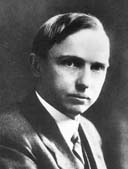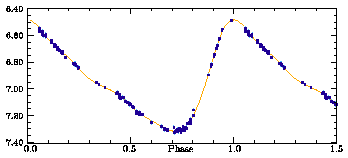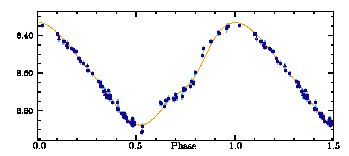Video lecture for this page
This material (including images) is copyrighted!.
See my copyright notice for fair use
practices. Select the photographs to display the original source in
another window.
 In the 1540's Nicolaus Copernicus removed the
Earth from the center of the
universe. He put the Sun at the center. Copernicus' view held up against the
observational evidence for hundreds of years. In the 1910's the Sun was
removed from the center of the universe and relegated to a typical patch in
the galactic disk far from the center of the Galaxy. Harlow Shapley
(lived 1885--1972) made this
discovery by determining the distances to very old star clusters. He used the
inverse square law of light brightness on a particular type of variable star in
those old star clusters.
In the 1540's Nicolaus Copernicus removed the
Earth from the center of the
universe. He put the Sun at the center. Copernicus' view held up against the
observational evidence for hundreds of years. In the 1910's the Sun was
removed from the center of the universe and relegated to a typical patch in
the galactic disk far from the center of the Galaxy. Harlow Shapley
(lived 1885--1972) made this
discovery by determining the distances to very old star clusters. He used the
inverse square law of light brightness on a particular type of variable star in
those old star clusters.
Some stars are very
useful for finding distances to clusters and to other galaxies because they
have a known luminosity that is large, so they can be seen from
great distances away. Bright objects of a known luminosity are called
standard candles (though, in our modern day we should perhaps call
them "standard bulbs"). Standard candle objects are used to measure large
distances. The particular standard candle stars Shapley used are in the
last stages of their life and pulsate by changing size. They are trying to
re-establish hydrostatic equilibrium but the thermal pressure is out of sync
with the gravitational compression. The expanding star overshoots the
equilibrium point. Then gravity catches up and contracts the star. But gravity
contracts the star beyond the equilibrium point. The thermal pressure increases
too much and the cycle continues.

In 1912 Henrietta Leavitt (lived 1868--1921) published the results
of her study of variable stars
in the Large and Small Magellanic Clouds. These are two small satellite
galaxies orbiting the Milky Way. The linear size of each Magellanic Cloud is
much smaller than its distance from us. Therefore,
to a good approximation all of the stars in each galaxy are at the same
distance from us. Leavitt found a very useful relationship for a certain type
of variable star called a Cepheid variable (after the prototype in
the constellation Cepheus; see
stage
6 of
a star's life cycle). The fainter Cepheids in the
Magellanic Clouds have shorter periods. Because all of the Cepheids in a
Magellanic Cloud are at the same distance from us, Leavitt reasoned that the
more luminous Cepheids pulsated more slowly. This is the
period-luminosity relation. Leavitt did not know the distances to the
Magellanic Clouds, so she could not tell what the actual value of the
luminosity part of the relation was.
Astronomers had to wait a few years for
Harlow Shapley to calibrate Leavitt's relation using Cepheids in our galaxy
for which the distances could be determined. In the calibration
process Shapley put actual values to the luminosity part of the
period-luminosity relation. With a calibrated period-luminosity relation
astronomers could use Cepheid variables as standard candles to determine the
distances to distant clusters and even other galaxies.
Cepheids have pulsation periods of 1 to 50 days. In the 1950's astronomers found
that there are two types of Cepheids:
- Type I: classical Cepheids are from young
"high-metallicity" stars (made of gas with significant amounts of processed materials from previous generations of stars) and are about 4 times more
luminous than Type II Cepheids. Below is the light curve (the plot of
brightness vs. time) of a classical Cepheid from the Hipparcos database of variable
stars.

- Type II: W Virginis Cepheids are from older
"low-metallicity"
stars (made of less polluted, more primordial gas) and are about 4 times less luminous than Type I. Below is the light curve of a
W Virginis Cepheid from the Hipparcos database of variable stars. Note the differences
in the shape of the light curve. The two types of Cepheids are distinguished from each
other by the shape of the light curve profile. In order to compare the shapes
without having to worry about the pulsation periods, the time axis is divided by the total
pulation period to get the "phase": one pulsation period = one "phase".

Because the luminosity of Cepheids can be easily found from the pulsation
period, they are very useful in finding distances to the star clusters or galaxies
in
which
they reside. By
comparing a Cepheid's apparent brightness with its luminosity, you can determine
the star's distance from the
inverse
square
law of light brightness. The inverse square law of
light brightness says the distance to the Cepheid = (calibration distance)
× Sqrt[(calibration brightness)/(apparent brightness)].
Recall that brightnesses are specified in the magnitude system, so the
calibration brightness (absolute magnitude) is the brightness you would measure
if the Cepheid was at the calibration distance of 10 parsecs (33 light years).
In some cases the calibration distance may be the already-known distance to another
Cepheid with the same period you are interested in. As described below, Cepheid variable stars are a crucial link in setting the scale of the universe.

Early measurements of the distances to galaxies did not take into account the
two types of Cepheids and astronomers underestimated the distances to the
galaxies. Edwin Hubble measured the distance to the Andromeda Galaxy in 1923
using the period-luminosity relation for Type II Cepheids. He found it was
about 900,000 light years away. However, the
Cepheids he observed were Type I (classical) Cepheids that are about four times
more luminous. Later, when the distinction was made between the two types, the
distance to the Andromeda Galaxy was increased by about two times to
about 2.3 million light years. Recent studies using various types of objects and techniques have
given a larger distance of between 2.5 to 3 million light years to the Andromeda
Galaxy (a measurement using eclipsing binaries gives a distance of 2.52 million light years; another measurement using red giants gives a distance of 2.56 million light years; another measurement using Cepheids gives 2.9 million light years; and measurements using RR-Lyrae give 2.87 to 3.00 million light years).


Another type of pulsating star similar to the Cepheids are the RR Lyrae
variable stars (named after the prototype star RR Lyrae). They are smaller than
Cepheids and, therefore, have shorter
periods and lower luminosities. They pulsate with a period between 5 and 15
hours (Cepheid pulsation periods are greater than 24 hours). Low-mass stars
will go through a RR Lyrae pulsation stage while the high-mass stars will go
through a Cepheid stage. Because low-mass stars live longer than high-mass
stars, the Cepheid stars as a group are younger than the RR Lyrae stars.
RR Lyrae are found in old star clusters called globular clusters and in the
stellar halo part of our galaxy. All of the RR Lyrae stars in a cluster have
the same average
apparent magnitude. In different clusters, the average apparent magnitude was
different. This is because all RR Lyrae have about the same average absolute
magnitude (=+0.6, or 49 solar luminosities). If the cluster is more
distant from us, the RR Lyrae in it will have greater apparent magnitudes
(remember fainter objects have greater magnitudes!).
RR Lyrae stars can be used as standard candles to measure distances out to
about 760,000 parsecs (about 2.5 million light years). The more
luminous Cepheid variables can be used to measure distances out to 40 million
parsecs (about 130 million light years). These distances are many thousands of
times greater than the distances to the nearest stars found with the
trigonometric parallax method. The method of standard candles (inverse square
law) provides a crucial link between the geometric methods of trigonometric
parallax and the method of the Hubble-Lemaître Law for very far away galaxies. (The
Hubble-Lemaître Law is
explained further
later.) In fact, this link between the parallax and the Hubble-Lemaître Law was so crucial that the diameter of the Hubble Space Telescope's mirror was primarily determined by how large a mirror (its resolving power and light gathering power) would be needed to pick out Cepheids in the other galaxies and the Cepheid distance measurement of 18 galaxies was one of the three Key Projects for the Hubble Space Telescope during its first decade of operation (see also). All of the pretty pictures of other objects during that time were just an extra bonus.
 Go back to previous section --
Go back to previous section --
 Go to next section
Go to next section
last updated:
June 27, 2022
Is this page a copy of Strobel's
Astronomy Notes?
Author of original content:
Nick Strobel
 In the 1540's Nicolaus Copernicus removed the
Earth from the center of the
universe. He put the Sun at the center. Copernicus' view held up against the
observational evidence for hundreds of years. In the 1910's the Sun was
removed from the center of the universe and relegated to a typical patch in
the galactic disk far from the center of the Galaxy. Harlow Shapley
(lived 1885--1972) made this
discovery by determining the distances to very old star clusters. He used the
inverse square law of light brightness on a particular type of variable star in
those old star clusters.
In the 1540's Nicolaus Copernicus removed the
Earth from the center of the
universe. He put the Sun at the center. Copernicus' view held up against the
observational evidence for hundreds of years. In the 1910's the Sun was
removed from the center of the universe and relegated to a typical patch in
the galactic disk far from the center of the Galaxy. Harlow Shapley
(lived 1885--1972) made this
discovery by determining the distances to very old star clusters. He used the
inverse square law of light brightness on a particular type of variable star in
those old star clusters.





